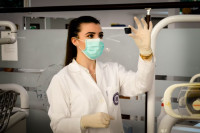The human being at the center - New Growth through diverse health
by Brigitte Liermann
Germany is diverse: Around 50% of people living in Germany are female and more than 20% are over 65 years old. 23% have a migration background and 10.8 million people have a recognized severe disability. But the diversity of society is not reflected in medicine.
Although there are plenty of growth opportunities for new products and services here. Opportunities that have been little exploited to date, because products and services are often developed without involving the relevant user groups or understanding their needs.
This must change. For reasons of inclusion, equality and accessibility, because legislation requires accessibility (European Accessibility Act 2025), but also quite simply because growth opportunities with great potential are not being exploited.
Much more than femtech
Particularly in the field of femtech, a lot has happened in recent years and many innovations have emerged. But most of the products and services deal with topics with typical female connotations, such as menstruation, fertility, pregnancy, maternal health, menopause or breast cancer. All very important topics. The market for femtech applications is estimated at USD 75 billion by 2025. But the potential is much greater: for more than 700 diseases, women receive a later diagnosis than men or, in the worst case, none at all.
That this is expensive for the healthcare system is one thing. But for affected women, it can be fatal. 50% of womenwho have a heart attack are misdiagnosed. The remedy is platforms and apps like CorDiFio, which helps women (and men) understand their heart risk factors, compile their general health information, and make it easier for doctors to see the risks at a glance, according to the Social Enterprise
But there's still a lot of work to be done. The good news is that women have a 75% higher interest than men in tracking their health. So the first step is to have confident and informative doctor-patient conversations.
Access as a premise
10.8 million people have a recognized severe disability. At least 17 million more people are restricted in their everyday lives. The number is alarmingly high and it will not decrease in view of an aging society. In addition, there are people with temporary or situational limitations. How would it be if products and services were designed and made for them from the outset? For tech companies like Apple or Microsoft, this is part of their growth strategy. From eye-based control, to live captioning, hand control without touching the screen, hearing aid pairing, read-aloud capability - Apple is developing features for its devices that ensure access. Microsoft is researching and developing on inclusion through AI, including launching the "Seeing AI" app - a talking camera for the blind. For people with disabilities, innovations like these make a huge difference.
As one campaign put it back in 2003: Disabled are those that have to manoeuvre restrictive environment. It's time to take the phrase to heart and work together to develop more inclusive products and services.
The human being at the center
Inclusion means taking into account the entire range of human diversity in terms of abilities, language, culture, gender, age and other forms of human differences in products and services. In healthcare in particular, this should be the premise by which development takes place. Not only because we all have a moral obligation to do so. But because otherwise growth opportunities and genuine potential for differentiation will remain untapped.


